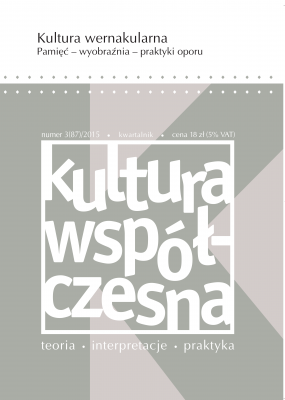Settings and search
Vernacular culture. Memory – imagination – practices of resistance


Table of contents
I VERNACULAR CULTURE. MEMORY – IMAGINATION – PRACTICES OF RESISTANCE
Marcin Napiórkowski
Invitation to vernacular culture
Marcin Napiórkowski, Artur Szarecki, Paweł Dobrosielski, Piotr Filipkowski, Olga Kaczmarek
Vernacular culture. Anthropology of unsuccessful projects
Lars Breuer, Anna Delius
How is vernacular memory being done? Selected results from an international study from Germany, Poland, Spain and Great Britain
Olga Kaczmarek
Jedwabne – peripheral knowledge
Piotr Filipkowski
Oral history – even more vernacular?
Paweł Dobrosielski
The “Jew with a coin” as a practice of the polish vernacular culture. A preliminary research report
Geneviève Zubrzycki
How to work through vernacular culture: concept-building, thick description and comparative analysis
Jonathan P. Eburne
Outsider art/outsider theory
Marcin Napiórkowski
To understand those who don’t understand. the structure of anti-scientific revolutions
Artur Szarecki
Post-vernacularity: affect and power in networked culture
II Cultural studies workshops
Wojciech Sitek
Poles in a net of the magnetic tape. Social character of the vhs tape universe, at the end of the 20th century
Anna Mazela
Collecting memories that are not our own. Limits of the vernacular character of the family photographs
Anna Zawadzka
Free to work, free of the husband. Women in the new anglo-saxon tv series
Miłosz Stelmach
Postcinema. “Final Cut: Hölgyeim és uraim”. György Pálfi’s movie as a post-cinema cinema
III Discussion in the editing team
Discussion: Discipline or studies? Qualitative research in the current knowledge landscape - Ewa Rewers, Maria Solarska, Anna Ziębińska-Witek, Marek Krajewski, Jan Sowa
IV Explanations
Patryk Szaj
Cioran exercises
Tomasz Błaszczyk
Deemed to damnation
Roman Chymkowski
Cultures of the anticipated future
Piotr Grochowski
Internet memes as a key to understand the cyber-culture
Vernacular culture. Memory – imagination – practices of resistance
Invitation to vernacular culture
- Marcin Napiórkowski
The category of “vernacular culture” is presented in the text as a methodological tool enabling the comparative analysis of various cultural products and practices, especially those deemed “unsuccessful” or “marginal” from the point of view of mainstream circulations. However, this category does not comprise of a closed set of definitional traits, but rather points to family resemblance, manifesting itself through a constellation of dimensions, such as structural subversiveness, lack of autonomy, familiarity, unawareness of own limitations, as well as amateur and emergent character.
In this article, we focus on vernacular memory as an important element of vernacular culture. Drawing on results from a qualitative study on ordinary European’s views of the past, we identify different carriers and strategies of vernacular memory contextualizing it with other memory realms, i.e. public memory. The analysis of the carriers shows that some of them are exclusively vernacular whereas other carriers can be used and shared by different realms of memory. Moreover, the analysis shows that due to their restricted instrumentarium, vernacular memory strategies are mostly characterized by reduction of complexity as well as of connections to individual biographies.
The article analyzes the changes of discourse and reactions surrounding the publication of Jan Tomasz Gross’s 2000 book Neighbors. The aim is to explain how and why the moment the knowledge about the pogrom in Jedwabne in 1941 became a matter of public discussions affected the primary circulation of that knowledge among the residents of Jedwabne. It then discusses the mechanisms of vernacular reactions to the knowledge of the pogrom carried out by the Poles becoming endorsed by the mainstream. The article is a preliminary analysis that points to areas of further research.
The text attempts at overcoming the dominant paradigm in contemporary practices of oral history, founded on an ethical rather than cognitive postulate of giving voice to those, who were deprived of it in traditional historiography. The author illustrates his diagnosis with a preliminary analysis of specific interviews. However, these case studies can be dubbed “unsuccessful”, as they break away from the logic of “giving voice”. Two variants of this breakaway are analyzed, both well known to oral history practitioners. The first one consists of a refusal to speak, as well as a non-traumatic silence and an underestimation of even the most significant historical experiences; the author calls it silent resignation. In contrast, in the second variant the respondent outtalks the researchers and imposes his or her own historical logic, quite distinct from the dominant and familiar one; the author describes it as loud usurpation. Both these breakaways are interpreted through the categories of vernacular culture.
The first part of the article is devoted to the vernacular image of the “Jew with a coin” and its connection to systemic academic and media discourses relating to anti-Semitism. The author analyzes historical roots of this practice, placing it in the context of historical prejudices, as well as in contemporary debates over the attitudes of the Polish people towards the Jews during and after the Second World War. The second part of the article presents preliminary results of quantitative research designed and conducted by the author, the aim of which was to establish the extent and exact forms of the practices related to the image of the “Jew with a coin”. The third, concluding part, shows the way in which the proposed concept of vernacular culture enables to shed new light on traditional interpretations of these phenomena, at the same time reassessing the results of quantitative research. This ‘familiar image’, wellestablished within the sphere of traditional superstitions, can be perceived as a reaction to the feeling of alienation that results from the level of complexity of the Polish Holocaust discourse – at the same time taking over its general sense and reversing its meaning. Thus, the above practice can be realized regardless of the awareness of alienation. It questions the asymmetry between the specialized public discourse and the common reception of it. Emphasis on the image itself simplifies the multi-layered debate on superstitions, capitalism and anti-Semitism, focusing solely on the material shape of the image.
The article discusses research strategies for a historically-grounded cultural sociology of identity formation and transformation. I develop two concepts – that of the national sensorium and of aesthetic revolt, and discuss the contribution of comparative analysis to the study of vernacular culture.
The text presents an analytic paradigm of “outsider thought”. The author points to similarities between phenomena from art history and intellectual history and concludes that conspiracy theories and eccentric scientific concepts have to be “discovered” for science in the same way as previously marginalized self-taught artists, exotic peoples or mentally ill persons were discovered for the art world.
The text offers a scientific perspective on anti-scientific phenomena, such as conspiracy theories, opposition to scientific consensus (e.g. the theory of evolution or global warming) or practices based on science (vaccinations). The author suggests that instead of condemning such stances as irrational we should rather try to understand their inner logic and search for social conditions that shape them.
The paper aims to theorize vernacular resistance in a networked culture. Analyzing the case of a digital marketing campaign prepared for the Polish Ministry of Interior, it argues for a systemic approach to cultural resistance as a dynamic process emerging from continual recombinations of discursive and affective flows. The campaign video generated numerous critical responses in the media as well as a series of vernacular remakes on YouTube. However, despite the ‘subversive’ qualities exhibited, many of them actually furthered social hierarchies by reconnecting with dominant cultural formations. Therefore, in a networked environment, organized by non-linear dynamics and complex interactions, vernacular resistance is impossible to locate and discern. However, it might persist in the multidirectional and largely accidental modes of propagation that reconfigure socio-cultural assemblages in unpredictable ways.
Cultural studies workshops
The aim of the present discussion is to reconstruct the atmosphere of he household film reception in the 1990s. The VHS tape is going to be the main object of interest, primarily in the context of mutual altruism principle, economy of the gift, which forced people to take part in the VHS exchange with the other collectors. Secondly, the question of transformation of the audio-visual reception model is going to be analyzed. Not only was the image consumption of the 1990s driven towards individual presentation, but also towards a social reception. The discussed medium was beneficial for this shared participation in the screening.
Vernacular character of the family photographs, which are most often taken at home, realizing a variety of purposes, without any market value, seems to be obvious. The situation is changed when the old private photos, separated from the source, are transferred to the antique shops or onto the collector’s market, and then they are included in the specific collections. The herein article analyses the transformation of the photograph and of the change of its vernacular status.
Not acting as an area for radical redefinition of the symbolic universe, the new TV series present the women in a way, in which you may recognize numerous emancipation intentions - the ones which try to replace the cultural myths and ideals with a realistic image, revealing the material and hierarchic dimensions of the interpersonal relationships. Work, home chores, social role of a wife, woman-woman relations, women as the crime victims - these themes are undertaken by the Anglo-Saxon TV series quite often. In the herein text, the author considers the possible interpretations.
By using the post-cinema category proposed by Chris Petit, the author analyses the film by György Pálfi: “Final Cut: Hölgyeim és uraim”. This innovative project constitutes an attempt to fuse the found footage techniques, with the contemporary feature films. As an effect, we are witnessing an auto-thematic and theoretical experiment which deals with the cinema’s ability within the cause-and-effect continuity and involvement of the viewer. At the same time, the double-meaning of the legal status of the film questions the categories of the copyrights and the contemporary ways of distributing and producing the content.
Discussion in the editing team
Discussion: Discipline or studies? Qualitative research in the current knowledge landscape - Ewa Rewers, Maria Solarska, Anna Ziębińska-Witek, Marek Krajewski, Jan Sowa
Explanations
Cioran – w pułapce istnienia, red. S. Piechaczek, Wydawnictwo Zakład Poligraficzny Sindruk, Opole 2014.
Donald de Marco, Benjamin D. Wiker, Architekci kultury śmierci, przeł. Grażyna Waluga, Fronda PL, Warszawa 2014.
Arjun Appadurai, The Future as Cultural Fact. Essays on the Global Cindition, Verso, London–New York 2013.
Limor Shifman, Memes in Digital Culture, Massachusetts Institute of Technology Press, Cambridge–London 2014.
